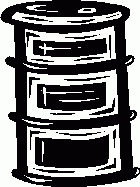What is Hazardous Waste?


- What Kinds of Wastes are “Hazardous?”
- Characteristically Hazardous Wastes
- Listed Hazardous Wastes
- Universal Wastes
- Used Oil
- Requirements for Other Wastes/Materials
What Kinds of Wastes are “Hazardous?”
Hazardous wastes include many kinds of discarded chemicals and other wastes generated from commercial, industrial, and institutional activities. Types of waste that are commonly hazardous include cleaning solvents, spent acids and bases, metal finishing wastes, painting wastes, sludges from air and water pollution control units, and many other discarded materials. Hazardous wastes may also include many items that you would not normally think of as being hazardous, such as:
- Batteries (can contain acids and bases, as well as metals like lead and cadmium)
- CRT-based computer monitors (contain lead)
- Thermostats and fluorescent lamps (contain mercury)
- Renovation and demolition waste (can contain lead-based paint)
Not all wastes are regulated as hazardous wastes. The wastes that are classified as “hazardous wastes” are spelled out in Section 101 of Connecticut’s Hazardous Waste Management Regulations. Connecticut’s regulations, in turn, incorporate Section 40 CFR, Part 261 of the federal hazardous waste regulations. [Exit DEEP website] Hazardous wastes may be divided into two basic groups: characteristically hazardous wastes and listed hazardous wastes .
Characteristically Hazardous Wastes
These are wastes that are hazardous because they exhibit a certain physical property or characteristic. There are four characteristics that can make a waste hazardous: ignitability, corrosivity, reactivity, and toxicity. A brief description of each of these four characteristics is provided below.
- Ignitable Wastes. A wastes is ignitable if: (1) it is liquid and has a flash point below 140 degrees Fahrenheit; (2) it is a flammable solid; (3) it is an ignitable compressed gas; or, (4) it is classified by the U.S. Department of Transportation as an oxidizer.
- Corrosive Wastes. A waste is corrosive if: (1) it is aqueous (i.e., water-based) and has a pH of 2.0 or lower (i.e., a strong acid) or 12.5 or more (i.e., a strong alkali); or (2) it can corrode steel at a rate of greater than ¼ inch per year.
- Reactive Wastes. There are many ways that a waste may be defined as a reactive waste. To briefly summarize, reactive wastes include wastes that are unstable, react with water or form hazardous mixtures with water, are capable of releasing toxic cyanide or sulfide gases under certain conditions, are explosive, or are capable of detonating under certain conditions.
- Toxic Wastes. A waste is toxic if it contains any of 40 different hazardous constituents at a concentration equal to or greater than a certain amount. These 40 constituents include 8 metals, 6 pesticides, 2 herbicides, 10 volatile organic compounds (VOCs), and 14 semi-volatile organic compounds (SVOCs).
For more information on characteristically hazardous wastes, see the DEEP’s Hazardous Waste Determination/Knowledge of Process Fact Sheet and the EPA’s Hazardous Waste Types Web Page [Exit DEEP website].
These are wastes that are hazardous because they are listed on one or more of four different particular lists of wastes:
- F-Listed Wastes. This list of wastes includes 28 different wastes, including certain spent solvents, metal finishing wastes, dioxin-containing wastes, chemical manufacturing wastes, wood preserving wastes, petroleum manufacturing wastes, and hazardous waste landfill leachate.
- K-Listed Wastes. This list of wastes includes over 100 wastes from specific industrial processes. The specific processes are in the industries of wood preserving, petroleum refining, primary and secondary metals manufacturing, and the manufacturing of industrial chemicals, inks, pigments, pesticides, explosives, and veterinary pharmaceuticals.
- U-Listed Wastes. This list of wastes includes several hundred different commercial chemical products. Wastes that fall under this listing include only those products that contain the listed constituent as the sole active ingredient. These wastes include old or off-specification virgin materials that are being discarded, as well as container residues and spill residues of these materials.
- P-Listed Wastes. This list of wastes includes about 200 different commercial chemical products that are defined as acutely hazardous. This means that the wastes are especially toxic. Wastes that fall under this listing include only those products that contain the listed constituent as the sole active ingredient. These wastes include old or off-specification virgin materials that are being discarded, as well as container residues and spill residues of these materials.
For more information on listed hazardous wastes, see the DEEP’s Hazardous Waste Determination/Knowledge of Process Fact Sheet and the EPA’s Hazardous Waste Types Web Page [Exit DEEP website].
This is a special subset of hazardous wastes that are regulated under a streamlined set of regulations called The Universal Waste Rule. These wastes include:
- Batteries. Covered batteries include lead-acid batteries, nickel-cadmium batteries, silver cells and mercury-containing batteries.
- Cancelled and recalled pesticides.
- Mercury thermostats and other mercury-containing equipment (e.g., mercury switches, barometers, sphygmomanometers, etc.).
- Mercury-containing lamps. This includes fluorescent lamps (including compact fluorescent lamps), mercury vapor lamps, and other lamps that contain mercury.
- Used electronics. This includes desk top and lap top computers, computer peripherals, monitors, copying machines, scanners, printers, radios, televisions, camcorders, video cassette recorders (“VCRs”), compact disc players, digital video disc players, MP3 players, telephones, including cellular and portable telephones, and stereos.
For more information on Universal Wastes, see the DEEP’s Universal Waste Rule Fact Sheet
Just as with Universal Waste, the hazardous waste regulations also have a special set of requirements for used oil. The term “used oil” means any oil refined from crude oil or synthetic oil, that: (A) has been used and as a result of such use is contaminated by physical or chemical impurities; or (B) is no longer suitable for the services for which it was manufactured due to the presence of impurities or a loss of original properties. This includes both used and unused oils that are being discarded. Common examples of used oils include:
- Used crankcase (engine) oil;
- Brake fluid, transmission fluid, and power steering fluid;
- Used gear, chain, and ball bearing lubricants;
- Hydraulic and compressor oils;
- Metalworking fluids (including water-soluble coolants);
- Drawing and stamping oils;
- Heat transfer oils (including quenching oils); and,
- Dielectric fluid (e.g., transformer oil).
For more information on used oil, see the DEEP’s Used Oil Web Page .
Requirements for Other Wastes/Materials
In addition to the hazardous wastes listed above, there are other wastes that, although they are not subject to hazardous waste requirements, must be handled in certain, special ways.
- Household Hazardous Wastes. These are wastes that are similar to the wastes listed above, but that are generated by residents in their homes while doing routine household activities. Examples of household hazardous waste include paints, stains, solvents, pesticides, old gasoline and other fuels, etc. These wastes are just as hazardous as their commercially-generated counterparts, but are not subject to hazardous waste requirements. However, DEEP encourages household residents to properly dispose of their household hazardous wastes by taking them to a DEEP-authorized household hazardous waste collection center or event. To find out more about household hazardous waste, see the DEEP’s Household Hazardous Waste Web Page.
- Non-RCRA-Hazardous Wastes (also known as Connecticut-Regulated Wastes). These are wastes that are not hazardous according to any of the definitions described above, but that are similar in nature to hazardous wastes. These include some paints (e.g., latex paints), solvents, and other chemicals. Even though they are not regulated as hazardous wastes, commercial generators of these wastes may not place them in the ordinary trash. For information on which wastes are considered “Connecticut-Regulated Wastes” and how these wastes must be managed, see the DEEP web page on Non-RCRA Hazardous Wastes.
- Polychlorinated Biphenyls (PCBs). PCBs (both those being disposed of and those that are still in-use) are subject to a special set of rules that are separate from the hazardous waste regulations. For details on the proper management of PCBs, see the DEEP’s PCB Web Page.
- Pesticides. As noted above, discarded pesticides are often regulated as hazardous wastes or as Universal Wastes. Even if they are not hazardous wastes or Universal Wastes, discarded pesticides would be considered “Connecticut-Regulated Wastes.” However, there is a separate set of DEEP requirements regarding the registration and use of pesticides. For more information on these requirements, see the DEEP’s Pesticide Management Program Web Page.
Questions? If you have questions about hazardous waste, call our toll-free COMPASS hotline at 1-888-424-4193, Monday through Friday, 8:30 a.m. to 4:30 p.m. (except state holidays), or send us an email.
Content Last Updated March 31, 2020

